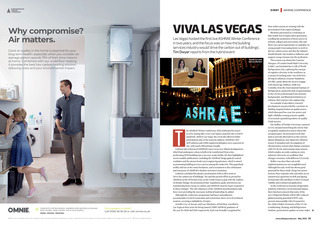


EVENT VIVA LAS VEGAS Las Vegas hosted the first live ASHRAE Winter Conference in two years, and the focus was on how the building services industry would drive the carbon out of buildings. Tim Dwyer reports from the hybrid event Jennifer Cox (left) and Lucy Sherburn T he ASHRAE Winter Conference 2022 celebrated its return to a live setting after a two-year hiatus caused by the Covid-19 pandemic. Held in Las Vegas, the event also allowed online participation and, in his welcome address, ASHRAE CEO Jeff Littleton said 2,000 registered delegates were expected on site, with nearly 500 joining virtually. Littleton also referenced ASHRAEs move to its new Atlanta headquarters, which had undergone a deep retrofit to be transformed from a lowperforming 1970s building into a net zero-ready facility. He then highlighted recent notable publications, including the ASHRAE Design guide for natural ventilation and the picture book Lucys engineering adventure, which is aimed at promoting building services careers among the under-10s. This paperback swiftly sold out at the onsite bookstore, and is testament to the enthusiasm and enterprise of ASHRAEs Student Activities Committee. Littleton concluded his plenary presentation with a call to arms to drive the carbon out of buildings. He said this period will be as pivotal for ASHRAE as the 1970s fuel crisis, as the world comes to grip with the realities of climate change. He pronounced that regulations, goals, and metrics are transitioning from energy to carbon, and ASHRAE must be hyper-responsive to these changes. The 140 volunteers of the ASHRAE decarbonisation task force were providing the necessary technical leadership, he added. Although the conference programme had been rationalised to accommodate Covid-19 constraints and restrictions, there were 52 technical sessions, covering a multiplicity of topics. Jennifer Cox, of Aecom, and Lucy Sherburn, of FairHeat, travelled to Las Vegas as their prize for being named CIBSE ASHRAE graduates of the year for 2020 and 2021 respectively. Each was formally recognised for | ASHRAE CONFERENCE their achievements in winning with the presentation of an engraved plaque. Sherburn presented at a workshop on Role models: how to inspire future generations, extolling the promotion of Stem careers in schools, colleges and universities. She said there was a great opportunity to capitalise on young peoples increasing desire to work in the low carbon sector, and that the industry should identify role models to influence and support young entrants into the profession. This session was chaired by Catarina Marques, of London South Bank University (LSBU), and included Steve Gill, of World Refrigeration Day, exploring the concept of cognitive diversity in the workforce as a means of reaching more out of the box, divergent solutions. Graeme Maidment, of LSBU, spoke about the need to engage with school-age children, while Ina Colombo, from the International Institute of Refrigeration, opined the lack of opportunities in the UK for professionals from minority backgrounds, and illustrated initiatives to enhance their journey into engineering. An example of speculative research development was provided by a seminar on Building-integrated indoor air quality sensors, which discussed low-cost, low-power and high-reliability sensing systems capable of accurately quantifying indoor air quality (IAQ) metrics. Zac Siefker, of Purdue University, reported on CO2 measurement being the metric that is regularly employed to assess IAQ in the occupied space. He presented work that aims to provide alternatives to the current, almost ubiquitous, non-dispersive infrared sensor. It included early investigation of chemiresistive sensors that change resistance with CO2 levels, and resonant mass sensors, which employ an oxide coating on a tiny substrate (driven by an oscillator) that changes resonance with different CO2 levels. Siefker was clear that real-world implementations are not straightforward. Although his early work has shown good potential for these small, cheap, low-power sensors, their response time and other, as yet unanswered, questions on drift and ageing of materials will contribute to their eventual viability and commercial application. As the world moves towards refrigeration solutions with lower environmental impact, there has been concern that some of the new refrigerant blends, which offer reduced global warming potential (GWP), may present unacceptable risks if exposed to fire. Helen Walter-Terrinoni, of the US AirConditioning, Heating, and Refrigeration Institute, presented an update on some major www.cibsejournal.com May 2022 23 CIBSE May 22 pp23-24 Ashrae conference.indd 23 22/04/2022 15:13